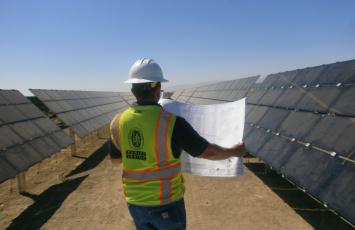Climate Change and the Future of Construction & Building Design
By Greg Bailey
Vice President, Engineering & Environment Division
It is hard to observe the weather and natural hazard events that have occurred in the recent past and not conclude that we need to design, locate, and build structures with an emphasis on our changing climate patterns. For example, the recent and continuing rain and snow events in California, where an entire year’s rainfall, in some regions, accumulated in less than two weeks. Just turn on the news or look out of the window to witness the increased severity of “mega” rain/flood, fire, drought, wind, hurricane, tornado, and snow events across the country.
We can look to the almost daily low-level tidal surges in parts of Miami and other Florida coastal areas that regularly deposit inches of water across inland roads, parking lots, and sidewalks. These events not only impact the life and safety of residents but create massive and potentially unsustainable economic impacts. Climate change has created a new word in the real estate industry “stranded asset” which is a building or property so impacted by climate and natural hazards that investors/lenders will not finance, insurers will not insure, and consumers will not purchase, and it, therefore, has almost zero market value. The opportunity and challenge for the design, construction and building industry are to find ways to significantly reduce the actual energy consumption and greenhouse gas emissions that this market sector contributes to the shifting climate patterns. The construction sector's greenhouse gas (GHG) emissions account for approximately 40% of global GHG emissions. The major contributors to these emissions are the production and transportation of building materials as well as the ongoing energy usage intensity of heating, cooling, and lighting systems. The increasing level of GHG contributed by the building construction industry requires what scientists call “decarbonization” or reducing the overall carbon emissions during the permitting, land planning, and design stages of the construction process.
The goals set by the Paris Climate Agreement to curtail global warming to below two degrees Celsius sets the focus of companies to reduce their carbon emissions to achieve net-zero carbon emissions by 2050. As a result of this lofty goal, the building design and construction industry is working to decarbonize building material production and processes during the design stage, material selection, manufacturing, transportation, and methods of installation.
Macro-level changes to the building and construction supply chain include:
- Continued changes in the building design and material specifications taking advantage of locally sourced materials, native planting, install more impervious hardscapes
- The implementation of climate-smart, low, and clean energy consumption in the use phase of real estate and infrastructure
- Lowering the contributing emissions of paints, caulks, sealants, and adhesives
- Lowering the carbon intensity of building materials in the production process of building materials
- The design of more recyclable materials and sustainable natural materials in the renovation and demolition phases
Damages or distress to buildings and property because of extreme weather events are unfolding weekly and require planning and analysis of how and where we develop and build. For example, the September 2022 Hurricane Ian’s impact on much of central Florida from coast to coast.
The policies, design, and planning measures that will be implemented because of Hurricane Ian’s highly destructive storm alone will be far-reaching and will potentially trickle into other coastal and climate-challenged locations. Building designers, insurers, lenders, and code officials are mindful of the increasing wind, rain, drought, and wildfire events across entire geographic regions. This increased awareness will inevitably change; how and where we build, building codes/policies, lender/investors underwriting criteria, insurance, and valuation.
Several building code and policy changes considerations are:
- Lowering the potential negative effects of the construction sector on the environment from changes in surface water flows from heavy rain or land use/zoning changes
- Rethinking stormwater management towards more climate-smart water management systems during the construction and after building occupancy
- New site and building designs that remediate climate impacts and leverage the changing climate to benefit the built environment e.g. solar, wind power, hydroelectric, geothermal, tidal ebb and flow, etc.
- Increasing the durability of materials against extreme weather conditions
- Specifying the highest efficiency heating/cooling and insulation systems feasible
What BV is doing to assist with this need!
The Engineering and Environmental due diligence division of BV North America has developed several service offerings to assist our clients with making decisions about their property portfolio and the impact of climate changes, GHG profile, and energy use intensity. BV currently offers a Climate Resiliency Assessment that models the current hazard profile and the year 2050 projections on the impact of drought, extreme heat, flooding, wind, wildfire, and seismic activity on the property and building. Secondly, we offer a companion product that evaluates potential energy conservation measures, energy usage intensity, greenhouse gas, and sustainability best practices to assist the client in evaluating and making decisions on the subject property.
The BV sales and technical teams are having regular conversations with clients about climate change impacts on buildings and properties and have received very positive feedback as well as delivered numerous large portfolios to clients with the addition of the climate resiliency and energy/GHG assessments.
To be better prepared to support our client in this complex and growing service line we are quickly becoming subject matter experts in the industry. Several of us from BV, myself included, are on the ASTM Property Resilience Assessment (PRA) committee which is responsible for developing an industry standard and best practices around climate change.
The new ASTM Property Resiliency Assessment standard is scheduled for release in mid-2023 and will be a catalyst in the real estate due diligence market that is needed to advance change.
Bureau Veritas as a leader in the building assessment and project management sector will be called upon to take action to advise on and manage climate change challenges that our clients struggle with in the constantly changing construction and development sector. BV must strive to be at the tip of the spear in assisting each other and our clients through a changing environment and assist in building resilience against the negative impacts of climate change on construction and buildings.


